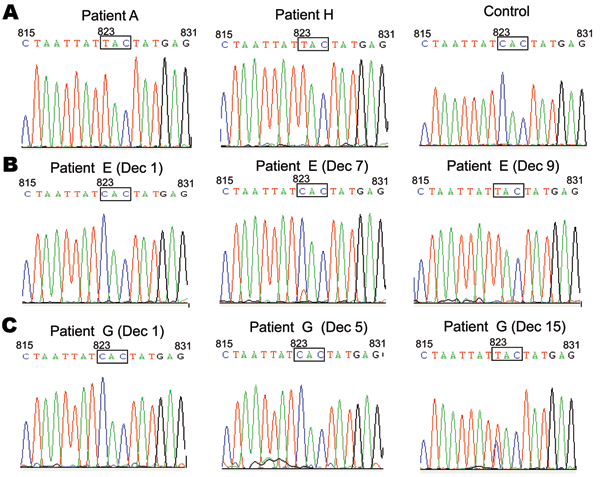Volume 16, Number 12—December 2010
CME ACTIVITY - Dispatch
Oseltamivir-Resistant Pandemic (H1N1) 2009 Virus, South Korea
Figure

Figure. Evolution of oseltamivir-sensitive H275 in pandemic (H1N1) 2009 virus to oseltamivir-resistant virus (mutation Y275) in the neuraminidase (NA) gene, South Korea. A) NA sequences of viruses from patient A, patient H, and strain A/Korea/01/2009 (H1N1) (Control) (Table 2). Viruses from these 2 patients had triplet TAC (encoding tyrosine in NA 275), indicating that these patients were infected with oseltamivir-resistant virus, in contrast to A/Korea/01/2009 (H1N1) of the oseltamivir-sensitive control showing CAC (encoding histidine) in NA 275. B) NA sequences from specimens obtained on different dates from patient E. This patient was initially infected with oseltamivir-sensitive virus with CAC in NA 275 (2009 Dec 1). Virus then showed mutation 823C (blue dominant peak) in the boxed CAC and a minor signal 823T (small red peak) in NA 275 (2009 Dec 7). In the third specimen (2009 Dec 9), only TAC in NA 275 was observed. C) Oseltamivir-sensitive virus infection (CAC in NA 275) was observed in the first 2 specimens from patient G (2009 Dec 1 and Dec 5). Mixed signals of dominant 823T (red peak) and minor 823C (blue peak) forms were seen in most recent specimen (2009 Dec 15), indicating a mixed infection with oseltamivir-resistant virus and oseltamivir-sensitive virus. Nucleotide coordinates (815 and 831) refer to NA gene sequence of pandemic (H1N1) 2009 virus. Amino acid residue 275 in the NA gene is encoded by 3 nt indicated in boxes.